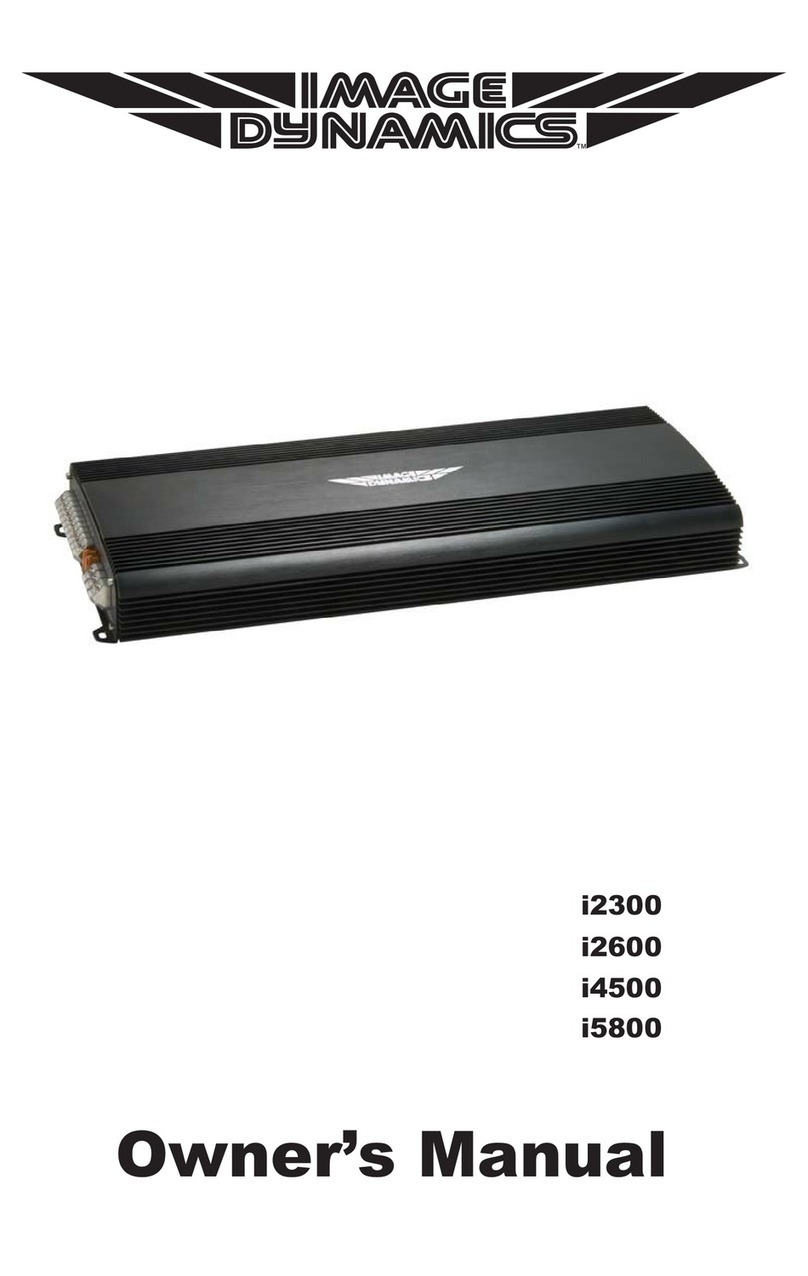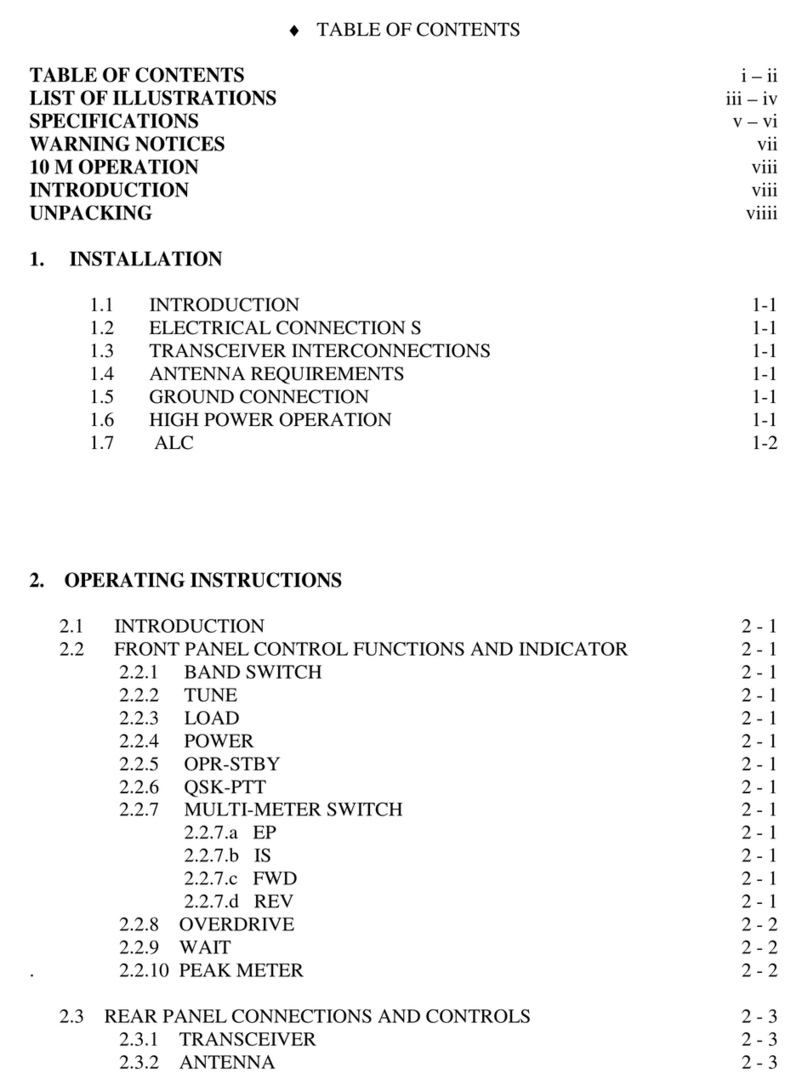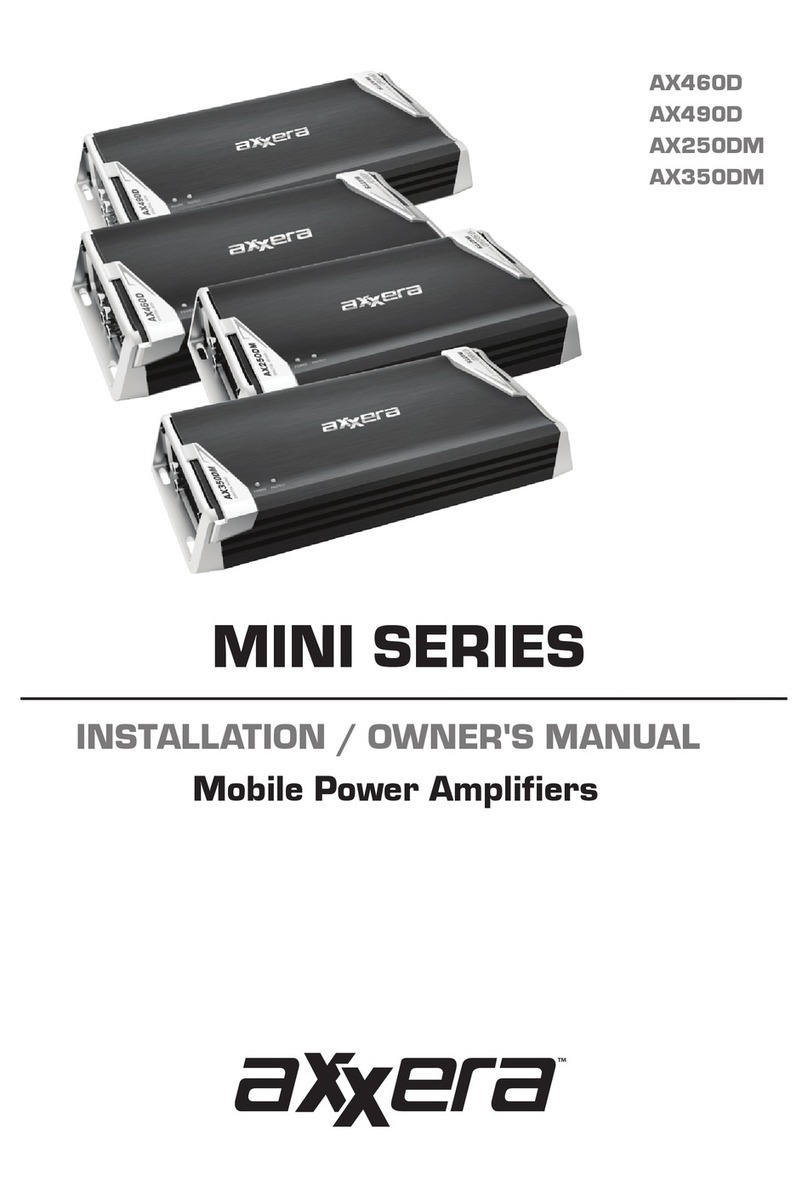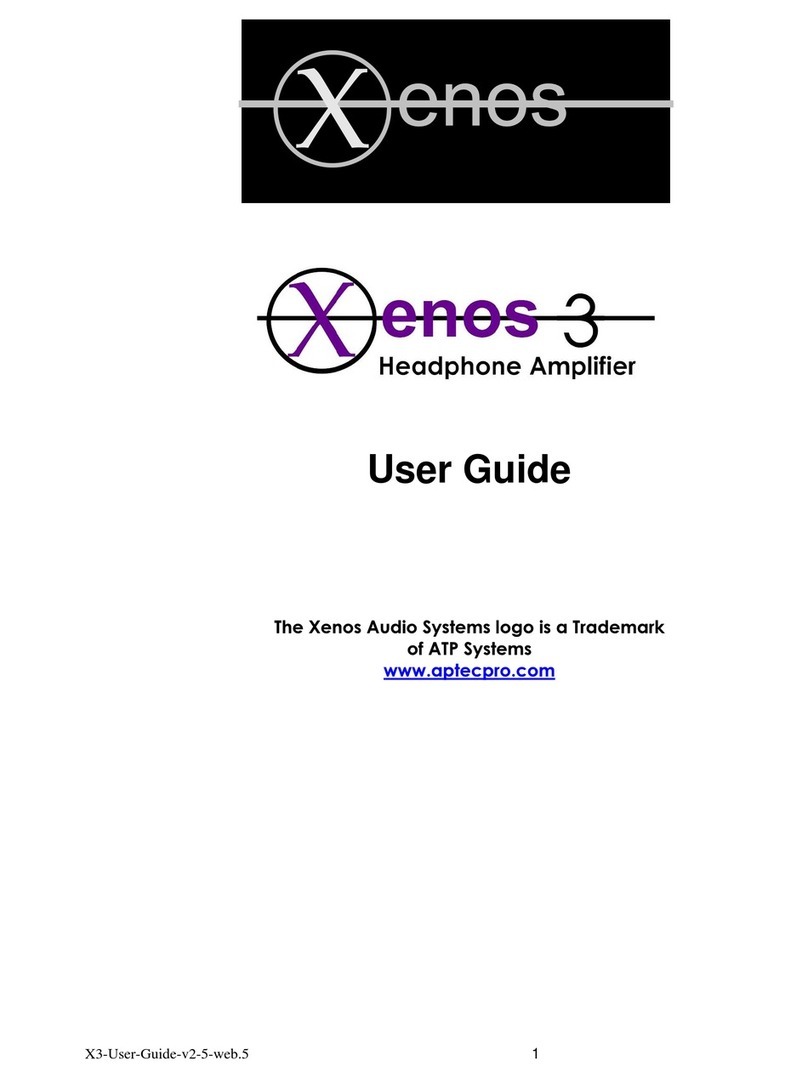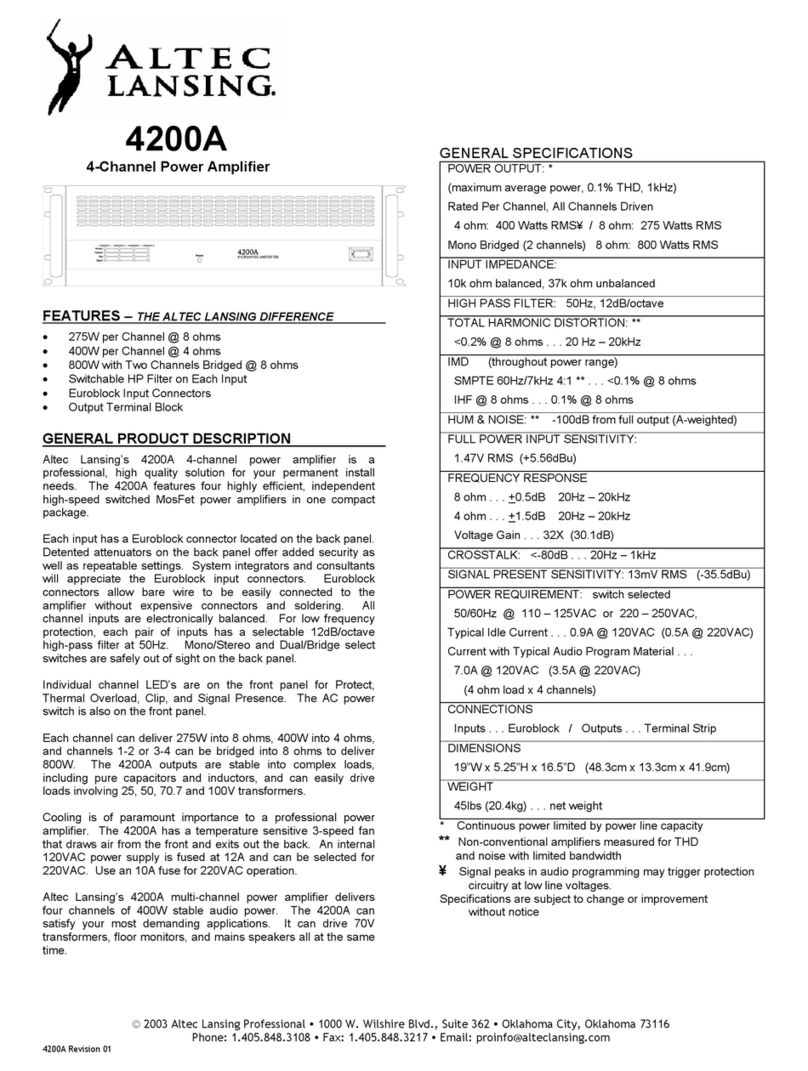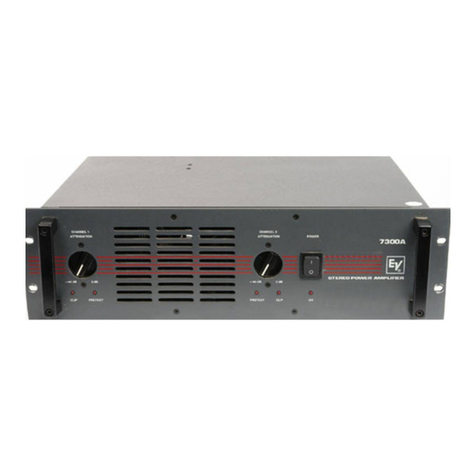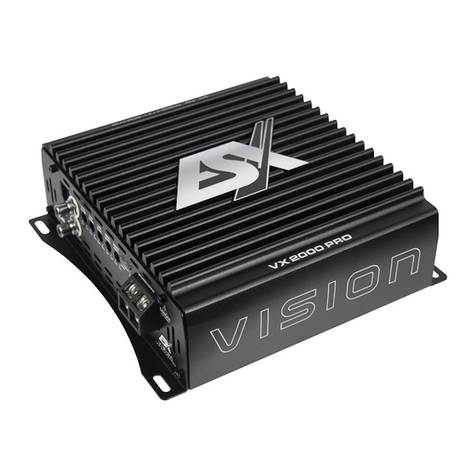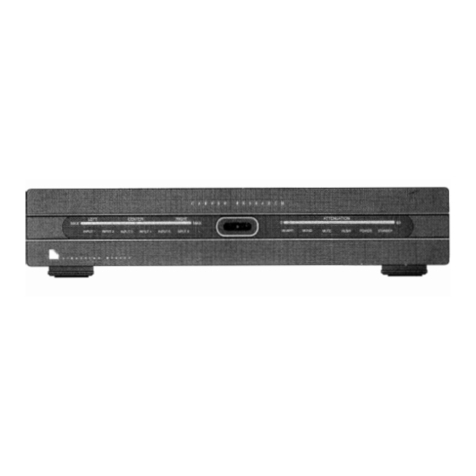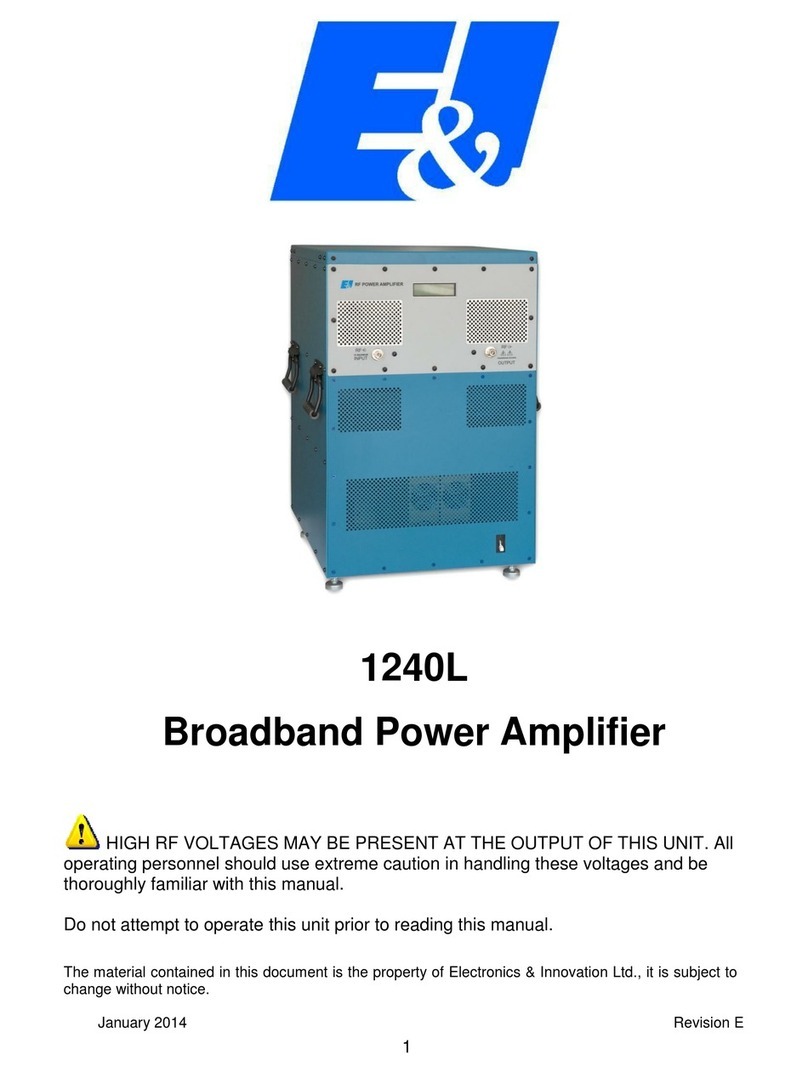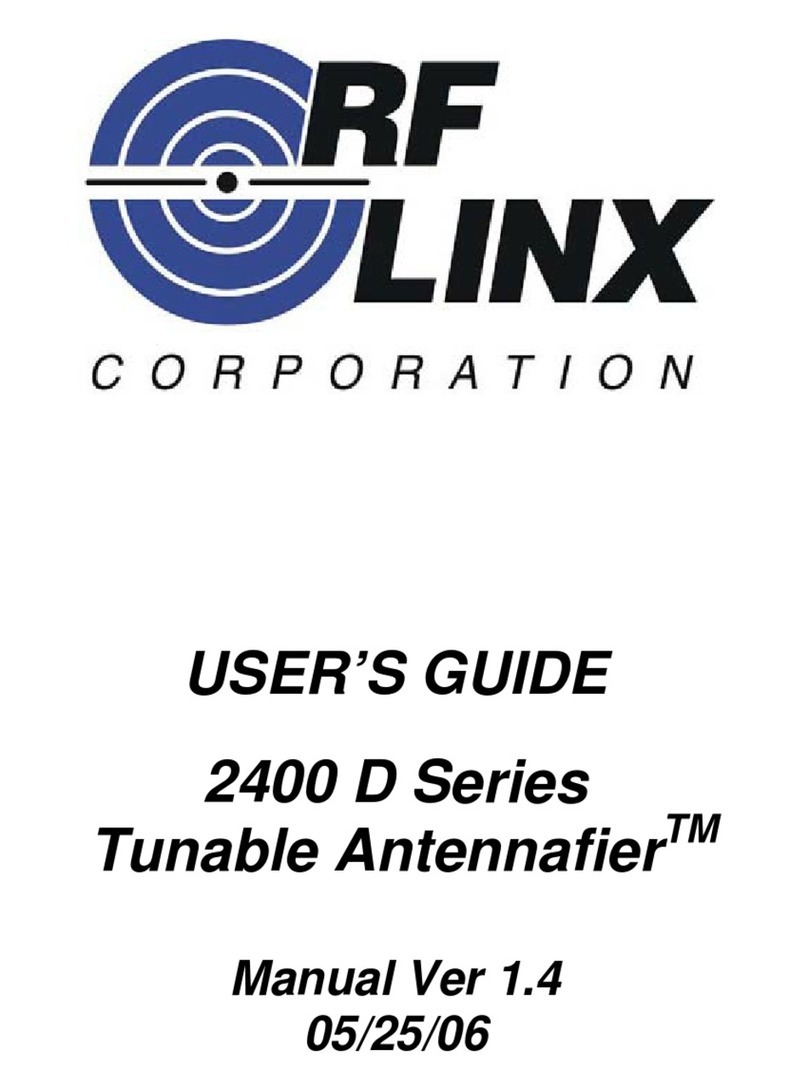Image Dynamics USA SQ800.4 User manual

SQ800.4
SQ1400.5
Please read through this manual to familiarize yourself with your new amplifier. Should your Image Dynamics
mobile amplifier ever require service, you will need to have the original dated receipt.
OWNERS MANUAL
SQ FULL RANGE DIGITAL AMPLIFIER

∆Caution ∆
High powered audio systems in a vehicle are capable of generating
higher than “Live Concert” levels of sound pressure. Continued ex-
posure to excessively high volume sound levels could cause hearing
loss or damage. Also, operation of a motor vehicle while listening to
audio equipment at high volume levels may impair your ability to hear
external sounds such as horns, warning signals, or emergency vehicles—
thus creating a potential traffic hazard. In the interest of safety,
Image Dynamics USA highly recommends listening at lower volume levels
when driving.
FULL RANGE CLASS D AMPLIFIERS
Thank you for your decision to purchase a Image Dynamics mobile amplifier! Our new
amplifiers are the result of extensive engineering, testing, and bullet proof construction.
Their versatility enables compatibility with optional signal and audio processors. These
high quality MOSFET amplifiers may be configured to allow maximum flexibility in design-
ing different types of speaker systems.
The Image Dynamics SQ Series are high quality MOSFET amplifiers that are capable of
running a system full range, or they may be selected only to power subwoofers. It is im-
portant that you closely follow the wiring instructions contained in this Owners Manual so
that you get the most from your Image Dynamics mobile amplifier.

TECHNICAL FEATURES
• FRD (Full Range Class-D) technology
• International Rectifier® Chip Set
• Ultra Low Current Draw
• High Damping Control Circuit
• High Efficiency SMD Circuit Technology
• Double Sided Copper Plated 4-Layer PCB
• Digital Sound Optimization Circuitry
• Quiet Switching
• High Current Voltage Ripple Rejection Circuitry
• Virtual Silence Turn On/Off Mute Circuit
• Advanced Protection Circuitry
• Balanced RCA Input Connectors
• 40 Click HPF/LPF Tone Controls
• Fan Cooling (SQ1400.5)
FRD-FULL RANGE CLASS D TECHNOLOGY
This amplifier represents the very latest in Class D technology. The SQ Series uses the
new IR® (International Rectifier) platform which has been under development for the past
several years. IR®, a leader in PWM circuit design, has worked in conjunction with Image
Dynamics engineers to produce more stable power output, minimal RF interference and
improved sound quality.
The benefits of this cooperative effort are many and include improved temperature, fre-
quency, voltage regulation and drive capability to name a few.
The result to the user is a all around improved product that will provide years of listening
enjoyment.
3
IR® is a registered trademark of International Rectifier Corporation.

INSTALLATION EXPERIENCE
Installation of Image Dynamics mobile amplifiers requires detailed knowledge of electron-
ics wiring and proper speaker impedance. We strongly recommend installation by an
authorized Image Dynamics dealer. This Owners Manual only provides general installa-
tion and operation instructions. If you have any reservations about your installation skills,
please contact your local Image Dynamics dealer for assistance.
IMPORTANT : This amplifier is designed for operation in vehicles with 12-volt Negative
ground electrical systems only.
PREPARING FOR INSTALLATION
NOTE: The tools listed below may be required for basic installation
• An electric drill with bits
• Philips head and standard screwdrivers
• Wire strippers
• Crimping tool
• VOM (electronic volt ohm meter)
• Heat shrink tubing and heat gun
• Soldering iron
• Electronic (Rosen not Acid Core) Solder
INSTALLATION PRECAUTIONS
NOTE: Proceed only if you are a qualified installer, otherwise; see
your Authorized Image Dynamics Dealer to professionally install this
amplifier. Always wear protective eyewear when using tools.
• Turn off all stereo and other electrical devices before you begin.
• Disconnect the negative (-) lead from your vehicles battery.
• Locate all fuel lines, brake lines, oil lines, and electrical cables when planning the
install.
• Make sure there is at least 2-inches (5 cm) around the air vents on the amplifier.
• When connecting ground points, make sure all paint is carefully scrapped away from
the auto body and contact is made with bare metal.
• Use a utility knife to trim away fabric from hole locations before drilling or cutting.
• When running power cables through sheet metal, be sure to use grommets to prop-
erly insulate the metal edges from the wire insulation.
• If possible, use tubing through grommets.
WARNING: Check your vehicle’s owner’s manual before disconnecting
the battery. Disconnecting the battery on some vehicles may require
an anti-theft code when reconnecting the battery and require the on-
board computer to be reset at the dealership. Check with your local
dealer if you are uncertain.
4

To keep your Image Dynamics running at top performance, choosing the proper location
is of utmost importance. Both Thermal and Overload protection are built in. In the event
of overheating, the amplifier may temporarily shut down operation. For this reason the
amplifier should be mounted in a location which will allow air to circulate freely.
MOUNTING LOCATION
Find a clear and well ventilated area to mount your amplifier that is unobstructed by any
objects that will cause harm or block ventilation. Despite the fact that this amplifier is
compact, it still needs air to cool the heatsink fins. Do not mount under a carpet or an area
with dead or stagnant air. Without proper air flow the amplifier may overheat and go into
protection where the thermal overload circuitry will shut down the amplifier.
NOTE: Make sure not to block the cooling fan (SQ-1400.5 only)
The amplifier should be protected from exposure to moisture and direct sunlight. The
compact size of the amplifier allows greater flexibility in mounting. The best places to
mount your amplifier are: The floor of the trunk, under the driver’s seat, or on the back of
the rear seat. For alternate installation locations, please consult your authorized Image
Dynamics Dealer.
If mounting under a seat, make sure there is at least 1-inch (2.5cm) of space above the
amplifiers heatsink to permit proper cooling.
You may use the amplifier as a template and mark the four screw locations with a felt tip
pen. Set the amplifier aside before drilling. Use caution to make sure there are no objects
behind the installation surface that may become damaged during drilling.
NOTE: Do not use a drill with a driver bit to mount the amplifier. Ex-
cessive force could cause the plastic mounting feet to crack.
Fig.1 Mounting Amplifier
5
Fan (SQ1400.5 only)

FUSE REQUIREMENTS
While the panel your Image Dynamics amplifier incorporates one or more fuses, these do
nothing to protect the vehicle from a dangerous short circuit. It is absolutely vital that the
main power lead to the amplifier(s) in the system be fused within 18-inches (45cm) of the
connection to the vehicle battery. The value of this fuse (or circuit breaker) should be no
greater than the sum of the fuses found on all of the equipment being connected to that
power wire.
SQ1400.5- 100 Amp Fuse
SQ800.4- 60 Amp Fuse
NOTE: Due to space limitations, the SQ 1400.5 does NOT use chassis
mounted protective fuses. Therefore you must add a fuse and fuse hold-
er (not included) rated at 100A for each SQ 1400.5 installed.
*** WARNING ***
• Do not install in a place where it could injure the driver or passengers if the vehicle
stops suddenly.
• Upside down mounting will compromise heat dissipation through the heatsink and
could engage the Advanced Protection Circuitry.
• Try to avoid mounting the amplier on a subwoofer enclosure, as extended exposure to
vibration may cause malfunction of the amplier.
• Don’t mount the amplier so that the wire connections are unprotected or are subject
to pinching or damage from nearby objects.
• The DC power wire must be fused at the battery positive (+) terminal connection. Before
making or breaking power connections at the amplier power terminals, disconnect the
DC power wire at the battery end.
• The battery of the car audio system must be disconnected until the entire wiring and
installation is completed.
6

CONTROL PANEL LAYOUT
NOTE: Panel Layout and Controls may differ by model.
1. Line Input Switch (SQ800.4 only)
This switch will let you use a single pair of RCA inputs to run all 4 channels of the amplifier or have
2 pair of RCA inputs to run all 4 channels of the amplifier separately. The SQ1400.5 has a subwoofer
input selector button that allows the input signal to be taken from the Rear Channel if selected. If the
subwoofer input button is selected at the Sub position, then a dedicated input needs to be used.
2. Line INPUT (RCA) Jacks
These RCA style input jacks are for use with source units that have RCA line level outputs. A source
unit with a minimum of 250mV is required for proper operation. However, this input will accept levels
up to 10 Vrms.
3. FRONT and REAR GAIN Control
This control is used to match the input sensitivity of the amplifier to the particular source unit that you
are using.
4. FRONT and REAR BASS EQ Switch for 0dB/9dB/18dB (SQ800.4 only)
This equalization circuit is used to enhance the low frequency response of the vehicles interior and
only works with LPF setting ON. Selectable to 0dB (flat) or 9dB to 18dB of boost centered at 45Hz, the
BASS EQ switch can be selected to meet your own personal tastes. Remember, more is not always
better.
Fig.2 Panel Layout
7

5. FRONT and REAR LPF (Low Pass Filter) 40 Click Detent Control
This control is continuously adjustable from 30Hz through 300Hz at 12dB per octave.
6. FRONT and REAR X-OVER Switch for LPF/FULL/HPF (SQ800.4 only)
Activates the built-in electronic crossover network. Works in conjunction with the LPF and HPF adjust-
able controls. When set to FULL, the two variable controls marked HPF and LPF have no effect on the
amplifiers output.
7. FRONT and REAR HPF (High Pass Filter) 40 Click Detent Control
This control is continuously adjustable from 50Hz through 300Hz at 12dB per octave.
8. POWER/STATUS Indicator
The clear LED lights Blue when the power is on—or turns Red constantly when the built-in protec-
tion circuitry is activated. Red indicates a problem with the system in relation to the amplifier. (See
Troubleshooting Tips on pg 25)
9. SPEAKER Output Terminals
This specially tooled solderless terminal block is designed to accommodate up to 10-gauge speaker
wire. Please refer to the wiring diagrams in this manual and be sure to observe speaker polarity and
impedance throughout the system.
10. FUSE(S)
For convenience most Image Dynamics amplifiers utilize common automotive ATC type fuses. For
continued protection in the event that a fuse blows, replace the fuse only with the same value (see
specification table). CAUTION: These power fuses on the amplifier chassis are for protecting the amp
against overdrive. To protect the vehicles electrical system, an additional fuse should be used within
18-inches of the battery on the 12V+ cable.
SQ1400.5 100A (Requires external fuse - not supplied)
NOTE: Due to space limitations, the SQ1400.5 does NOT use chassis
mounted protective fuses. Therefore you must add a fuse and fuse hold-
er (not included) rated at 100A for each SQ1400.5 installed.
11. BATT+ (Power Input Connection)
This solderless terminal is the main power input for the amplifier and must be connected directly to the
12-volt Positive (+) terminal of the car battery. The terminal can accept up to 4-gauge wire (see Power
Cable Selection Chart for the minimum recommended wire gauges).
12. REM (Remote Input Connection)
All Image Dynamics amplifiers can be turned on by applying 12 volts to this terminal. This can be
found on the rear of the source unit in the form of a remote output. If this is not available you can wire
to the ACC position on the key. An 18 gauge wire is sufficient to run the REMOTE.
13. GND (Ground Input Connection)
A good quality ground is required for your Image Dynamics amplifier to operate at peak performance.
A short length of cable the same gauge as the Power cable should be used to attach the Ground termi-
nal directly to the chassis of the vehicle. Make sure that all of the paint is sanded or scraped away to
ensure a good ground connection.

*** WARNING ***
Disconnect the negative (-) battery terminal before you start any wiring work! The bat-
tery of your car audio system must be disconnected until the entire wiring installation is
completed.
Your Image Dynamics amplifier requires unrestricted current to deliver peak performance,
so do not “starve” your amplifier by using small power cable. Using under sized power
cable can result in unnecessary over-heating of the amplifier, distortion at high volume
levels and might even cause the thermal protection circuitry to shut-off the amplifier. Re-
member, bigger wire is better!
• Use rubber grommets when running cables through any metal or sharp plastic to
prevent accidental shorting or shearing. Make sure the cables do not interfere with
normal operation of the vehicle.
• The audio signal cables (RCA interconnects) should be kept far away from any poten-
tial sources of electrical interference such as electronic vehicle management systems
(relays, engine computers etc.), wiring harnesses, fuel pumps etc.
POWER WIRING AND SIGNAL CONNECTIONS
Fig.3 SQ1400.5 Power Input Connection
9
FUSE HOLDER
Battery Within 18"
of Battery Remote Turn ON
Chassis
Ground
(–)

These amplifiers are designed to work within a 10 to 16 volt DC range. Before any wires
are connected, the vehicles electrical system should be checked for correct voltage supply
with the help of a voltmeter.
First, check the voltage at the battery with the ignition in the OFF position. The voltmeter
should read no less than 12V. If your vehicles electrical system is not up to these specifica-
tions, we recommend having it checked by an auto electrician before any further instal-
lation. Once the vehicle is checked, make certain the correct cable gauge is used. The SQ
amplifier terminals are capable of accepting up to 4 gauge power and ground cable. We
recommend using as large a gauge cable as possible, use the Power Cable Selection Chart
to calculate the correct power wire size for your application.
POWER WIRING
BAT T+ (Po wer)
This amplifier should be wired directly to the vehicle battery using the appropriate size
cable. Start at the vehicle battery and run the power cable through to the amplifier. Avoid
running the power cable over engine components and near heater cores. The use of an in-
line fuse or circuit breaker is a must; this will prevent the risk of a potential fire caused by a
short in your power cable. Connect the fuse holder or circuit breaker as close to the battery
positive (+) terminal as possible (within 18” from the battery). This fuse or circuit breaker
should be no greater then the sum of the fuses found on the chassis of your amplifier (also
see specifications chart). You may now connect the cable to the battery, but remember to
leave the fuse out or circuit breaker “off” until all other cable connections are made.
GND (Ground)
When grounding your amplifier, locate a metal area close to the amplifier that is good
source of ground (preferable the floor pan). Use a short length of cable the same gauge
as your power cable. Once again, investigate the area you wish to use for electrical wires,
vacuum lines, and brake or fuel lines. Use either a wire brush or sandpaper to eliminate
unwanted paint for better contact of the ground.
Secure the ground cable to the body using a bolt, star washer and nut. Spread silicon
over the screw and bare metal to prevent rust and possible water leaks.
NOTE: The Ground must be capable of carrying the same amount of cur-
rent as the positive wire.
Fig.4 Ground Connection

Now it’s time to connect the power and ground cables to the amplifier. Cut both cables
to length. Strip off 1/2 inch (12mm) of the insulation so that the bare wire fits all the way
in the terminal block on the side panel of the amplifier, seating it firmly so no bare wire is
exposed. Use a screw driver to loosen the BATT+ and the GND connection on the ampli-
fier. Insert the ground first, and then the +12V and please make sure that you place them
into the correctly marked terminals. Hand thighten the set screws and make sure the con-
nection is secure to prevent possible arcing due to loose screws.
REM (Remote Trigger)
This terminal must be connected to a switched +12V source. Typically, a remote turn-on
lead is provided at the source unit that will turn on and off the amplifier in correspondence
with the source. If this lead is not at the source unit, then a switched +12V supply must be
used, like the ACC, +12V.
Run a minimum of 18 gauge wire from the amplifier location to the source of the switched
+12V lead. If possible, route this wire on the same side of the vehicle as your power cable.
Connect the source remote output to the wire. Go back to the amplifier and cut the wire to
length. Loosen the screw terminal marked REM on the amplifier. Insert the stripped (bare)
portion of the wire into the terminal and tighten the screw securely.
NOTE: It is highly recommended that an Allen wrench is used to tighten
the set screws in the terminal blocks by hand and NOT a power drill.
This will prevent stripping or other possible damage to the amplifier.
11

Low Level Input - Choose the correct length and style of RCA interconnects for your
needs. Always use high quality RCA audio cables (not supplied) for signal connections—
those with multiple layers of shielding or a twisted pair variety for better noise rejection.
Be extra careful when routing your RCA audio interconnect cables. Car environments are
notorious for poorly insulated wires. This means that hiss, engine noise, and fan noise
can easily be picked up through RCA cables if run incorrectly.
Make sure that the cables for power and audio signal are not on the same side of the
vehicle and that they do not cross each other; this will help reduce any noise that may ra-
diate from the power cable and the signal cable. If an audio cable is too close to a power
cable, it may pick up the magnetic field generated by the power cable, which could lead
to a loss of quality in your signal.
RCA INTERCONNECT (SQ800.4)
Fig.5 Low Level Input using RCA
POWER REMOTE ANT
CAR RADIO
RCA OUTPUTS
GND
DC 14.4V
BATTERY
GND
—
+
12

Fig.6b Low Level Input using
single RCA
Fig.6a Low Level Input using two
RCAs
13
RCA INTERCONNECT (SQ800.4)
Single RCA OUT
Dual RCA OUT (Front and Rear)

Single RCA OUT
Dual RCA OUT (Front and Rear)
Single RCA Output on the Radio (Rear
only). In the event the car radio (head
unit) you are using has only 1-set of RCA
preamp outputs, you will need to split
the signal using “Y” adaptors on the
Right and Left channels as shown above.
Since the radio's 2V (or possibly lower)
pre out signal is split between 3 sets of
inputs, the GAIN controls will need to be
set considerably higher to maximize the
amplifiers ouput. By doing this you will
lose the Front to Rear fader capability as
only the Rear RCA is being used.
Dual RCA Output from the Radio
(Front and Rear)
If the car radio (head unit) you are using
has 2-sets of RCA preamp outputs you
will retain the full balance and fade capa-
bilities of your radio. With the SUB INPUT
button “out” the subwoofer is unaffected
by fade Front to Rear.
Y adaptors
SQ1400.5
Fig.7a
Fig.7b
14

Three RCA OUT (Front and Rear plus Subwoofer)
Three RCA Outputs from the Radio (Front and Rear plus Subwoofer)
This is the optimum configuration for this amplifier by providing 3-sets of discrete signal
to the preamp. It will also offer the most flexibility in tuning the system.
15
SQ1400.5 (continued)
Fig.7c

This control allows you to match the input level of the amplifier to the output level of your
head unit. Matching the input can be accomplished in three simple steps:
1. Set the volume of GAIN on the amplifier to Min (completely counter clock wise).
2. Turn on the head unit and adjust volume to 2/3 maximum, and set the BASS and
TREBLE to zero.
3. Adjust the GAIN control clockwise until the sound just begins to distort, then back off
slightly to cut distortion and operate at optimum gain.
Remember, the GAIN control is not a volume control. Ignoring the three steps above may
leave you with damaged speaker and/or a damaged amplifier.
SET UP ADJUSTMENTS
INPUT Gain Adjustment
Fig.9 GAIN Control
GAIN
MINMAX
HPF (High Pass Filter) 40 Click Detent Control
When you are using coaxial or component speaker system, this allows you to adjust high-
pass X-over frequency from 50Hz to 300Hz. To get better sound quality from coaxial or
component speaker system, we recommend the frequency should be higher than 80Hz.
Make sure the X-OVER switch is positioned at “HPF”. See the charts on pages 22-24 to set
the High Pass Filter to the precise frequency for your particular amplifier.
BASS EQ Switch
This special feature is designed to provide you more powerful sound quality, and it al-
lows you to boost the real Bass EQ up +18dB. The level of boost can be set to either 0 (no
boost), +9dB or +18dB. Keep in mind that more is not always better! Setting the control to
the max (18dB) can stress the amplifier and the speakers which may result in damage to
your system.
Fig.10 Bass EQ Control
Fig.11 High Pass Control (HPF)
9dB
16

17
SPECIAL CONTROLS FOR THE SQ1400.5 The following instructions apply to the mod-
el SQ1400.5 only. You will not find these controls on any of the other models in this
series.
Sub Input Button
The SQ1400.5 is a 5-channel amplifier that incorporates an advanced crossover net-
work and a Subwoofer Remote Level control. You are able to select which of the 4 in-
puts that subwoofer signal is sourced to. With the Subwoofer Source button in the out
position the subwoofer will receive its signal from a sum of the FRONT/REAR inputs.
With the button in, the subwoofer signal will come from the SUB inputs.
BASS EQ Variable Control
This special feature is designed to provide you more powerful sound quality, and it
allows you to adjust the Bass EQ up to 18dB at 45Hz. Keep in mind more is not always
better. Setting the control to the max (18dB) may stress the amplifier and woofer and
could result in damage.
LPF (Low Pass Filter) 40 Click Detent Control
Using this potentiometer, adjust the LPF frequency for your subwoofer speaker(s) opera-
tion. The X-OVER switch position should be at “LPF”. Use the enclosed chart to precisely
dial in desired frequency. See the charts on pages 22-24 to set the Low Pass Filter to the
precise frequency for your particular amplifier.
Fig.12 Low Pass Control (LPF)
Input Mode Switch (SQ800.4)
Matches the input from the Source Unit to that of the amplifier, either 2 or 4 Channel. This
eliminates the use of “Y” adapters and provides a cleaner input signal.
Fig.13 2-4 Channel Input Mode
CH2CH4
INPUT MODE
INPUT
30Hz 300Hz

SPEAKER WIRING AND CONFIGURATIONS
Speaker Load
Keep in mind your Image Dynamics amplifier is a high power amplifier and not a high
current amplifier. In other words this amplifier requires a minimum impedance of 2 ohms
STEREO or 4 ohms bridged MONO to operate trouble free. Lower impedance will send the
amplifier into protection and possibly damage the electronics inside and void the waranty.
The SQ1400.5 is stable to 2-ohms on the SUB channel.
NOTE: Know your total impedance load before you make any connections.
Speaker Wiring
Choose the correct speaker wire for your application. Most applications will require a mini-
mum of 16 gauge wire. Route these using the same precautions as you did when you ran
the power cable. Terminate these wires at the speaker end using insulated speaker termi-
nals (not supplied) or by soldering the connection. Make sure the speaker connections are
positive-to-positive and negative-to-negative. At the amplifier end, it is very important
that the wires are making solid contact. Strip the wires insulation back approximately 1/2
inch (12mm) and insert the wires into the appropriate openings while being careful there
are no loose or frayed strands of wire straying from the terminal. Check to make sure
you’ve maintained proper polarity and balance.
CAUTION
Maintaining proper impedance is critical when wiring the Full Range
Digital model amplifiers. Improper wiring can cause severe damage to
BOTH the woofer and the amplifier. Detailed wiring diagrams are sup-
plied with all Image Dynamics woofers.
IF YOU ARE NOT EXPERIENCED OR UNCOMFORTABLE READING THE WIRING DIA-
GRAMS CONSULT YOUR AUTHORIZED Image Dynamics DEALER BEFORE YOU ATTEMPT
TO WIRE THE SYSTEM.
18

19
Speaker Output Connections 4 Channel Model (SQ800.4)
3. 4-Channel Speaker Output Connection
4. 3-Channel Stereo/Mono Speaker Output Connection
5. 2-Channel (Bridged Mode) Speaker Output Connection
Fig.17 3-CH Speaker Connection
Fig.18 2-CH Speaker Connection / 4 ohms minimum
Fig.16 4-CH Speaker Connection / 2 ohms minimum
OR
OR

SPEAKER OUTPUT CONNECTIONS 5 CHANNEL MODEL
(SQ1400.5)
6. 5-Channel Speaker Output Connection
7. 3-Channel Speaker Output Connection
Fig.20 3-CH Speaker Connection
Fig.19 5-CH Speaker Connection / 2 ohms minimum
2 ohm
minimum
2 ohm
minimum
FULL RANGE SPEAKERS
2 ohm
minimum
2 ohm
minimum
FULL RANGE SPEAKERS
SUBWOOFER
2 ohm minimum
20
This manual suits for next models
1
Table of contents
Other Image Dynamics USA Amplifier manuals
